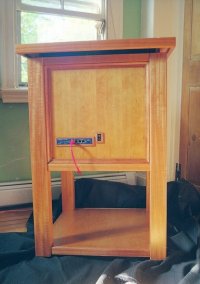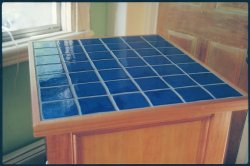
home about case
1 2 3 4 5
p a g e
While the frame is mahogany, the panels are quarter-inch cherry veneered plywood. The paneled design allows for very tight tolerances around the face hardware, as plywood is dimensionally stable (meaning it doesn't expand and contract as moisture levels vary).

Finally, the left panel reveals a four port ethernet hub, and RCA audio outputs. Having struggled with mini-to-RCA cables which would not reach my stereo for years, the RCA outs provide very nice flexibility for room layouts.
The final picture of the exterior is the tiled top. It is laid on a piece of three-quarter inch plywood, with the biscuited1 and edge glued band of mahogany concealing the edge of the tile. The tiles themselves are each unique; they are all two wonderful shades of deep blue and none are perfectly square. The grout is a medium shade of grey, and provides just the right amount of contrast between the tile and wood.

The last bit about the exterior is about the bottom shelf. It's designed to hold most any printer (I have an IBM 4019E laser which fits with plenty of extra room). There's a bottom panel on the top enclosed portion, and has cutouts for the printer's data cable and air intakes.
This brings us to the fundamental design of the case. The components are mounted in a custom wooden chassis, which is mounted like a large rear-opening drawer. Power is supplied through a cord which passes through the front left leg. more...
1 The term ‘biscuited' refers to a woodworking process in which thin [american] football shaped discs of wood (biscuits) are used to keep two pieces of wood aligned while they are being glued together; the biscuits also add a small amount of strength to the glue joint. Biscuiting is accomplished by cutting a small, shallow notch with a spinning circular blade (the blade is a disc, and spins in the same way as a bicycle wheel) whose teeth cut away the wood. The biscuits themselves come in several sizes (all the same thickness), and the size of the slot is regulated by how far the circular blad is pushed into the piece to be joined.